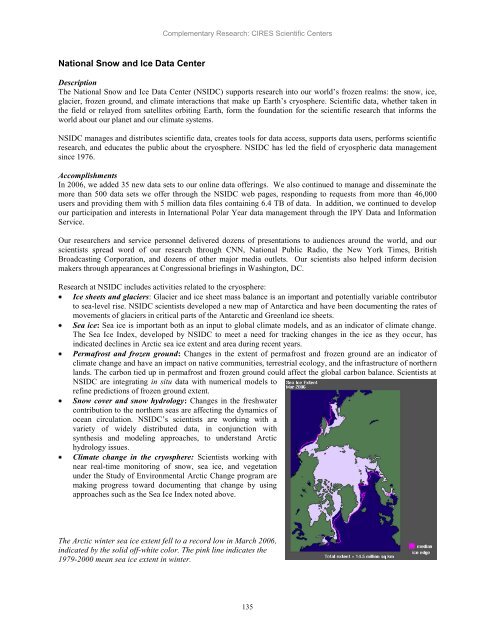Scientific Theme: Advanced Modeling and Observing Systems
Scientific Theme: Advanced Modeling and Observing Systems
Scientific Theme: Advanced Modeling and Observing Systems
You also want an ePaper? Increase the reach of your titles
YUMPU automatically turns print PDFs into web optimized ePapers that Google loves.
National Snow <strong>and</strong> Ice Data Center<br />
Complementary Research: CIRES <strong>Scientific</strong> Centers<br />
Description<br />
The National Snow <strong>and</strong> Ice Data Center (NSIDC) supports research into our world‘s frozen realms: the snow, ice,<br />
glacier, frozen ground, <strong>and</strong> climate interactions that make up Earth‘s cryosphere. <strong>Scientific</strong> data, whether taken in<br />
the field or relayed from satellites orbiting Earth, form the foundation for the scientific research that informs the<br />
world about our planet <strong>and</strong> our climate systems.<br />
NSIDC manages <strong>and</strong> distributes scientific data, creates tools for data access, supports data users, performs scientific<br />
research, <strong>and</strong> educates the public about the cryosphere. NSIDC has led the field of cryospheric data management<br />
since 1976.<br />
Accomplishments<br />
In 2006, we added 35 new data sets to our online data offerings. We also continued to manage <strong>and</strong> disseminate the<br />
more than 500 data sets we offer through the NSIDC web pages, responding to requests from more than 46,000<br />
users <strong>and</strong> providing them with 5 million data files containing 6.4 TB of data. In addition, we continued to develop<br />
our participation <strong>and</strong> interests in International Polar Year data management through the IPY Data <strong>and</strong> Information<br />
Service.<br />
Our researchers <strong>and</strong> service personnel delivered dozens of presentations to audiences around the world, <strong>and</strong> our<br />
scientists spread word of our research through CNN, National Public Radio, the New York Times, British<br />
Broadcasting Corporation, <strong>and</strong> dozens of other major media outlets. Our scientists also helped inform decision<br />
makers through appearances at Congressional briefings in Washington, DC.<br />
Research at NSIDC includes activities related to the cryosphere:<br />
Ice sheets <strong>and</strong> glaciers: Glacier <strong>and</strong> ice sheet mass balance is an important <strong>and</strong> potentially variable contributor<br />
to sea-level rise. NSIDC scientists developed a new map of Antarctica <strong>and</strong> have been documenting the rates of<br />
movements of glaciers in critical parts of the Antarctic <strong>and</strong> Greenl<strong>and</strong> ice sheets.<br />
Sea ice: Sea ice is important both as an input to global climate models, <strong>and</strong> as an indicator of climate change.<br />
The Sea Ice Index, developed by NSIDC to meet a need for tracking changes in the ice as they occur, has<br />
indicated declines in Arctic sea ice extent <strong>and</strong> area during recent years.<br />
Permafrost <strong>and</strong> frozen ground: Changes in the extent of permafrost <strong>and</strong> frozen ground are an indicator of<br />
climate change <strong>and</strong> have an impact on native communities, terrestrial ecology, <strong>and</strong> the infrastructure of northern<br />
l<strong>and</strong>s. The carbon tied up in permafrost <strong>and</strong> frozen ground could affect the global carbon balance. Scientists at<br />
NSIDC are integrating in situ data with numerical models to<br />
refine predictions of frozen ground extent.<br />
Snow cover <strong>and</strong> snow hydrology: Changes in the freshwater<br />
contribution to the northern seas are affecting the dynamics of<br />
ocean circulation. NSIDC‘s scientists are working with a<br />
variety of widely distributed data, in conjunction with<br />
synthesis <strong>and</strong> modeling approaches, to underst<strong>and</strong> Arctic<br />
hydrology issues.<br />
Climate change in the cryosphere: Scientists working with<br />
near real-time monitoring of snow, sea ice, <strong>and</strong> vegetation<br />
under the Study of Environmental Arctic Change program are<br />
making progress toward documenting that change by using<br />
approaches such as the Sea Ice Index noted above.<br />
The Arctic winter sea ice extent fell to a record low in March 2006,<br />
indicated by the solid off-white color. The pink line indicates the<br />
1979-2000 mean sea ice extent in winter.<br />
135
















